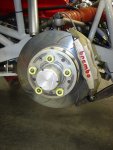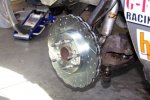Sorry, thought you would know plac.
So Sonny, same question. Why do all the OEM's go with drilled rotors on all their high performance car's then?
Late to the party, sorry. In regards to slotted or drilled rotors: The function of a rotor is basically to act as a heat sink. When you remove material from a rotor (i.e. slots or holes) you limit the ability of a rotor to dissipate heat. Some do tout the benefits of slotted rotors cleaning the pads or assisting when a pad out-gasses. However, in my opinion, less is not more when it comes to braking. That being said....they look awesome
So Sonny, same question. Why do all the OEM's go with drilled rotors on all their high performance car's then?

